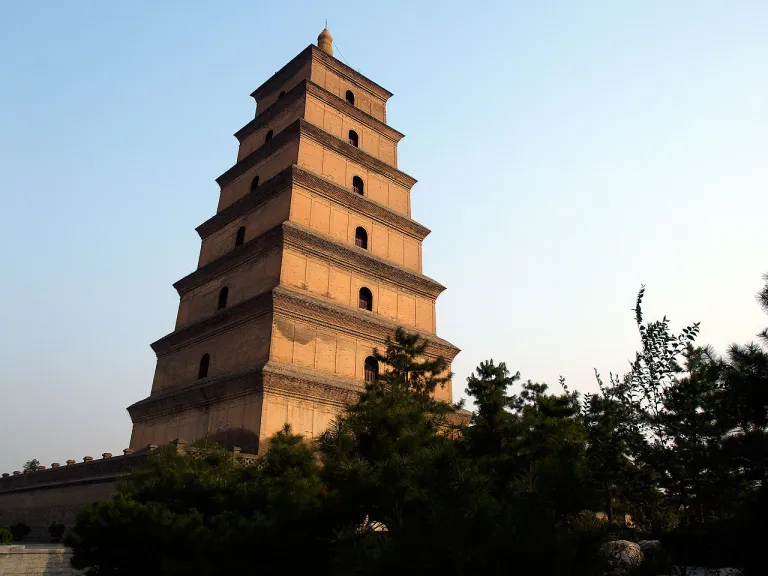Revised January 2021. Needs more thought…
The pagoda seems to sprout from earth,
Appearing to touch Heaven itselfClimbing we leave the world behind,
With each step suspended in space.Overlooking this sacred place
Built by the toil of the human spirit.Its four sides darken the bright light,
Its seven stories slice the silvery clouds;And birds descend below our sight,
The wind whistling below us listening;Mountains tower in the east,
Curving and flowing, like rivers.In the distance locust-trees outline highways
Leading to clusters of palaces and mansions;Colors of autumn, out of the west,
Advancing, enter the city;Northward in five graveyards, there lay
At peace under dewy green grass,The mass of those who know life’s final meaning
A message humanity will learn.So, I will put my official hat (office) aside.
The Dao (the Way, Eternal Way) is our only happiness.
The Tower
Today, it is better known as the Big Wild Goose Pagoda (大雁塔). It was built during the Tang Dynasty and was surely and object of admiration for poets, politicians, and social climbers alike. Climbing the seven stories, step by step, looking down below, would have been a metaphor both poets and politicians.
When Cen Can (岑参, 715–770) wrote this poem, Tang China had reached its Golden Age. Cen Can was likely in his 30s and flush with success. In about 751, Cen met Gao Shi (704–765), Du Fu (712-770), and Li Bai (701 -762). Each of whom was a poet of some success, all of them achieving mention in the anthology Three Hundred Tang Poems. Cen Can’s reference to Xue Ju is unclear, at least to me. One can find mention of Xue Ji, calligrapher and chancellor to Emperor Ruizong, but he died in 713.
Ahead were the dark days of the An Lushan Rebellion that began in 755. becomes a metaphor for gaining royal favor or a metaphor for ascending to heaven in his poem Climbing Ci’en, the Buddhist Temple of Mercy and Kindness, with Gao Shi and Xue Ju.
The Title
与高适薛据同, 登慈恩寺浮图, Yu Gao Shi Xue Ju, Deng Ci’en Si Fu Tu Hokkien
The poem’s title is generally given in English as Ascending the Pagoda at the Temple of Kind Favor with Gao Shi and Xue Ju. Within the temple grounds is the pagoda. Its name, Big Wild Goose Pagoda, omitted by Cen Can. Cen Can subtly says that though we can achieve riches and success with the kindness and favor of the Imperial Court, only the Dao, The Way, do we find happiness.

Da Ci’en Temple
The Buddhist temple grounds of Da Ci’en (慈恩 寺, kindness, mercy, temple), is located in the ancient capital of the Tang Dynasty, Chang’an, now Xi’an, in Shaanxi province. The meaning of “Ci’en” can be translated as the “mercy and kindness of a loving mother”.
In 648, Emperor Gaozong (Li Zhi) ordered the construction of the temple and its pagoda to honor his dead mother. The temple grounds are known as Da Ci’en and sometimes Dacien, in English translations. The famous pagoda is the Giant Wild Goose Pagoda which rises to seven stories. It was originally five stories, but, after its collapse, it was rebuilt in 704 to seven stories by the emperor’s spouse, the Empress Wu Zetian.
The well-known Buddhist monk Xuanzang (602 – 664) lived there, taking charge of the temple’s business and gathering under its roof classic scriptures, statues, and Buddhist relics (Sariras) which he acquired during his 17-year-long trip to India. Based on his journey to India, he wrote a book, Pilgrimage to the West. The reference to the locust tree in line 13 is likely to the Chinese scholar tree or Pagoda tree which is generally planted in front of temples and leading to cities. The reference to the cemetery of Wuling in line 17 is to the tombs of the five emperors of the Han Dynasty.*
Original Chinese Characters
与高适薛据同, 登慈恩寺浮图
塔势如涌出, 孤高耸天宫
登临出世界, 磴道盘虚空
突兀压神州, 峥嵘如鬼工
四角碍白日, 七层摩苍穹
下窥指高鸟, 俯听闻惊风
连山若波涛, 奔凑如朝东
青槐夹驰道, 宫馆何玲珑
秋色从西来, 苍然满关中
五陵北原上, 万古青蒙蒙
净理了可悟, 胜因夙所宗
誓将挂冠去, 觉道资无穷
Pinyin
Tǎ shì rú yǒng chū, gū gāosǒng tiāngōng;
Dēnglín chū shìjiè, dèng dào pán xūkōng.
Túwù yā shénzhōu, zhēng róng rú guǐ gōng;
Sìjiǎo ài bái rì, qī céng mó cāngqióng.
Xià kuī zhǐ gāo niǎo, fǔ tīngwén jīng fēng.
Lián shān ruò bōtāo, bēn còu rú zhāo dōng.
Qīng huái jiā chí dào, gōng guǎn hé línglóng.
Qiūsè cóng xī lái, cāng rán mǎn guānzhōng.
Wǔ líng běiyuán shàng, wàngǔ qīng méngméng.
Jìng lǐle kě wù, shèng yīn sù suǒ zōng.
Shì jiāng guàguān qù, jué dào zī wúqióng
*Royal tombs of the Han emperors were cut horizontally into rocky hillsides. A shaft led to an underground suite of rooms, which became the deceased emperor’s residence in the afterlife.
The tomb was provided with the luxuries of court life – furniture, kitchen utensils, food and toiletries, tools, weapons, jewellery, and other “necessary” royal appurtenances, including the deceased’s unfortunate concubines, cooks and servants, who were sacrificed to serve their master in the next life.











